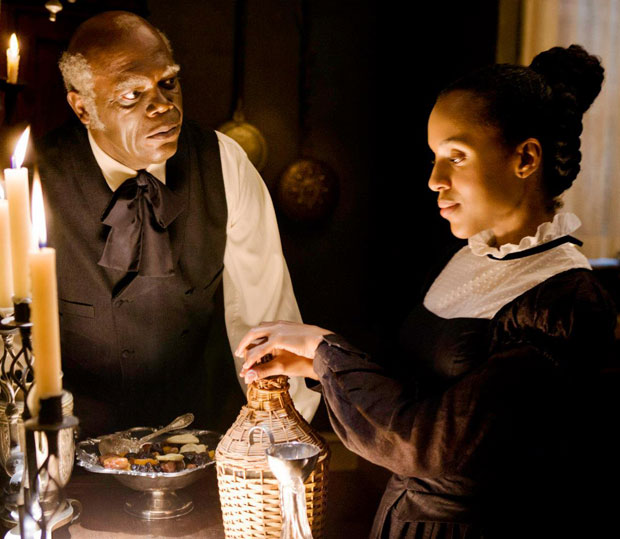
Quentin Tarantino loves history. Sometimes it’s personal history: flashbacks and forwards allow movies like Reservoir Dogs, Pulp Fiction, and Kill Bill to fluidly bounce around time, the juxtaposition of the “then” and “now” creating illuminating collisions. Sometimes it’s grander history: Inglorious Basterds and his new film, Django Unchained, unveil the grimmer truths of World War II and the slave-owning American South, respectively. But it’s hard to call Tarantino a historian, as the film-buff-turned-filmmaker filters his explorations through exploitations. This is the guy who had his violent Jewish band of brothers tommy gun Hitler in a burning movie theater. Tarantino loves history, but offers his own imaginative version of it.
Tarantino has taken liberties once again with Django, prioritizing the magic of cinema over striving for truth, while never driving the film into unbelievable territory. Obviously, it’s enraging a few choice people — Spike Lee won’t even see the movie, which depicts a slave-turned-bounty-hunter blasting his way to his enslaved wife — but Tarantino sticks to his guns. As he writes in an essay for the New York Times, “Any of the Western directors who had something to say created their own version of the West … When you learn of the rules and practices of slavery, it was as violent as anything I could do — and absurd and bizarre. You can’t believe it’s happening, which is the nature of true surrealism.”
One of the movie’s major quick-call-the-fact-checker moments is a brutal scene involving “Mandingo Fighting.” A gambling pastime of the wicked plantation owner Calvin Candie (Leonardo DiCaprio), the sequence boils down to a wrestling match to the death, with two slaves punching, kicking, and slamming each other until there’s a victor. The sequence prompted historians to speak up about the troubling sport. David Blight, the director of Yale’s center for the study of slavery, explained to Slate that sending slaves to fight didn’t make monetary sense. Edna Greene Medford, chairperson of the history department of Howard University, told NextMovie that after years of studying slavery, the Civil War, and Reconstruction, she had never encountered anything resembling “Mandingo Fighting.” Knowing these facts only plays to Tarantino’s intentions with the scenes: they may not factually true, but they feel like they could be in the frightening world of the Antebellum South.
Tarantino’s inclusion of the wrestling match is likely born from his enjoyment of the 1975 blaxploitation film Mandingo, which he cites the book Quentin Tarantino: Interviews as one of his favorites. Tarantino shaped a career out of paying homage to the films he deems classics, using them as seeds for his own wild concoctions rather than spoofing them sloppily. Following the Western genre’s basis of truth (the West was truly wild after the 1873 Supreme Court Case Taylor vs. Taintor expanded the roles of bail bondsmen and bounty hunters), Tarantino had freedom to collage Spaghetti Westerns, specifically the works of original Django director Sergio Corbucci, with iconography of the South. Django also takes its cues from other blaxploitation — from camera zooms to the anachronistic music cues, Tarantino lays on a level of badassery common the ’70s into into his period film. Many cineastes see a connection to 1972’s The Legend of Nigger Charley, which made similar attempts to blend gunslinging and blaxploitation.
One of the most fascinating and divisive characters in the film is Samuel L. Jackson’s Stephen, an older house slave who acts as a puppeteer to DiCaprio’s Candie. Stephen doesn’t pull any punches with his fellow slaves, more master than companion to the “lower class” that worked on Candie’s plantation. As mind-boggling as Stephen’s relationships might seem (Jackson’s quotes in interviews acknowledging his study of the film slavery exploitation film Goodbye Uncle Tom as a reference for the character), it’s Tarantino exaggerating an actual social ladder that actually existed at the time. Ira Berlin’s 2003 book Generations of Captivity, the author elaborates on the lives of black slaveholders and their general emergence into slave-owning culture. As he puts it, “In slave societies, nearly everyone – free and slave – aspired to enter the slaveholding class, and upon occasion some former slaves rose into slaveholders’ ranks.” Django’s aggressive campaign to win back his wife without any bloodshed also speaks to this established hierarchy. While it does end in a big Western shootout, the setup calls back to the history books.
In the end, going through Django Unchained with a fine-toothed comb looking for authenticity is a fleeting effort. In some places it’s there, but Tarantino is a cowboy when it comes to working with “facts.” He’ll take them when he needs them, but his real goal is finding an emotional core and crafting great cinema. If that means Django’s wife Broomhilda is written as a sexually abused runaway slave (which has historical accuracy), then in the world of Tarantino, she can also be the distant relative of blaxploitation icon Shaft (and she is). Anything goes in the in the Wild West world of Tarantino.
[Photo Credit: The Weinstein Company]
Follow Matt Patches on Twitter @misterpatches
More:
In Honor of ‘Django Unchained’: The 20 Greatest Spaghetti Westerns Ever Made
Frank Ocean Wrote a Song for ‘Django Unchained’? — LISTEN
Do ‘Django,’ ‘Les Mis,’ and Really Long Movies Need Intermissions? — POLL





